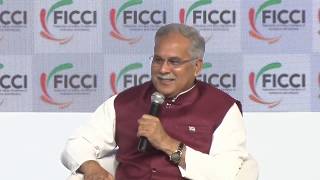
भाजपा प्रत्याशी सुरेंद्र पटवा के समर्थकों के लिए अच्छी खबर। नामांकन किया गया मान्य
INH,
#INH24x7 #Haribhoomi #MadhyaPradeshNews #ChhattisgarhNews #LatestNews #BreakingNews #TodayNews
Source : ANI \ Studio \ INH Reporters \ Agencies
Copyright Disclaimer Under Section 107 of the Copyright Act 1976, allowance is made for "fair use" for purposes such as criticism, comment, news reporting, teaching, scholarship, and research. Fair use is a use permitted by copyright statute that might otherwise be infringing. Non-profit, educational or personal use tips the balance in the favor of fair use.
आईएनएच 24x7 मध्य प्रदेश और छत्तीसगढ़ का सर्वश्रेष्ठ हिंदी न्यूज चैनल है। यह चैनल देश के बहुप्रतिष्ठित हिंदी दैनिक समाचार पत्र समूह हरिभूमि का ही ऑर्गेनाइजेशन है। आईएनएच 24x7 न्यूज चैनल राजनीति, क्राइम, मनोरंजन, बॉलीवुड, व्यापार और खेल में नवीनतम समाचारों को शामिल करता है। आईएनएच 24x7 न्यूज चैनल की लाइव खबरें एवं ब्रेकिंग न्यूज के लिए बने रहें। आईएनएच 24x7 के साथ देखिये देश-प्रदेश की सभी महत्वपूर्ण और ताजातरीन खबरें...
Watch the Latest Hindi News Live on INH 24x7
लेटेस्ट खबरों से अपडेट रहने के लिए हमारे New Youtube Channel “INH 24x7” को Subscribe करें।
INH 24x7 is The Best Hindi News Channel of Madhya Pradesh and Chhattisgarh. This Channel is the organization of the country's most Prestigious Hindi daily News Paper Group Hari Bhoomi . INH 24x7 News Channel Covers Latest News in Politics, Crime, Entertainment, Bollywood, Business and Sports. Stay Tuned for Live News and Breaking News From INH 24x7 News Channel. With INH 24x7, watch all the important and Latest News of the country and the state ...
Download INH 24x7 APP : On Android and IOS ????
URL : https://play.google.com/store/apps/details?id=in.inhnews.live
खबरों से अपडेट रहने के लिए INH 24x7 से जुड़िए- ????
INH 24x7 Telegram ???? : https://t.me/+22_aahu6_44yZTJl
INH 24x7 Whatsapp ???? : +91 99930 22843
Follow this li
च्या कडून Inh News| 416 दृश्ये

Saiyami Kher on Ghoomer | Exclusive Interview | Crictracker
The talented and gorgeous Saiyami Kher, who is making waves with her latest film Ghoomer. Plays the role of Anina Dixit, a cricketer who loses her right hand in an accident and makes a comeback as a one-handed bowler. The film, directed by R Balki and co-starring Abhishek Bachchan, has received rave reviews from critics and audiences alike.
Saiyami talks about her experience of working on Ghoomer, her preparation for the role, her passion for cricket, her friendship with Sachin Tendulkar and Rohit Sharma, and much more. She will also reveal some interesting facts about her personal and professional life, such as how she started modelling, why she turned down Zoya Akhtar's offer for Luck By Chance, how she impressed Roger Federer with her tennis skills, and what are her future projects.
Don't miss this candid and fun conversation with Saiyami Kher, who is not only a brilliant actor but also a sports enthusiast. Watch the video till the end and don't forget to like, share and subscribe for more such videos.
Stay tuned to Crictracker for more cricket updates, and don't forget to like, share, and subscribe to our channel.
#cricket #cricketnews #cricketvideo #crictracker
Follow us on:
Website - https://www.crictracker.com
Facebook - https://www.facebook.com/crictracker
Instagram - https://www.instagram.com/crictracker
Twitter - https://www.twitter.com/cricketracker
LinkedIn - https://www.linkedin.com/company/crictracker
Telegram - https://ttttt.me/crictracker
Saiyami Kher on Ghoomer | Exclusive Interview | Crictracker
च्या कडून CricTracker| 765 दृश्ये

#PokhranRajasthan #RajasthanAssemblyElections2023 #Congress #SalehMohammad
Watch JAN TV on :
Tata Play DTH : 1185
Airtel DTH: 355
JIO Fiber: 1384
https://www.youtube.com/jantvindia/live
Make sure you subscribe to our channel and never miss a new video:
https://www.youtube.com/jantvindia
https://www.facebook.com/jantvindia
https://www.instagram.com/jantvindia/
https://twitter.com/JANTV2012
http://www.jantv.in
Jan TV Live | Hindi News LIVE 24X7 | Jan TV Live | Hindi news 24X7 LIVE
Jan TV | Hindi News Jan TV Live | Jan TV News | Jan TV Live
News Credit – NR
Pokhran Rajasthan | Assembly Elections 2023, कांग्रेस ने सालेह मोहम्मद पर फिर जताया भरोसा
च्या कडून JANTV RAJASTHAN| 312 दृश्ये

Robotic Process Automation enables users to create software robots, or #Bots, that can observe, mimic & execute repetitive, time consuming #Digital #business processes by studying human actions.
Watch the video to know how RPA is transforming #businesses.
#ArtificialIntelligence
Robotic Process Automation is transforming businesses across the world
च्या कडून CII| 207865 दृश्ये

#latestnewsupdates #breakingnews #news #uttrakhand #pushkarsinghdhami #budgetsession #bjp #vidhansabha #news #jantv
Watch JAN TV on :
Tata Play DTH : 1185
Airtel DTH: 355
JIO Fiber: 1384
https://www.youtube.com/jantvindia/live
Make sure you subscribe to our channel and never miss a new video:
https://www.youtube.com/jantvindia
https://www.facebook.com/jantvindia
https://www.instagram.com/jantvindia/
https://twitter.com/JANTV2012
http://www.jantv.in
Jan TV Live | Hindi News LIVE 24X7 | Jan TV Live | Hindi news 24X7 LIVE
Jan TV | Hindi News Jan TV Live | Jan TV News | Jan TV Live
News Credit -VKJ
Dehradun Live | विधानसभा में बोले रहे सीएम पुष्कर सिंह धामी उत्तराखंड विधानसभा सत्र का आगाज
च्या कडून JANTV RAJASTHAN| 2779 दृश्ये

Pakistan vs Bangladesh | ODI World Cup 2023 | Match Stats Preview, Pitch Report | CricTracker
Welcome to CricTracker, your one-stop destination for everything related to cricket. In this video, we will preview the 31st match of the ICC ODI World Cup 2023 between Bangladesh and Pakistan, which will be played at the Eden Gardens in Kolkata on October 31.
Bangladesh and Pakistan are two of the most unpredictable and exciting teams in world cricket. Both have a rich history of producing some memorable matches in the past, and this one promises to be no different. Both teams are looking to gather momentum and secure their place in the semi-finals.
In this video, we will give you a match stats preview, pitch report, and playing11 for both teams. We will also share our predictions and opinions on who has the edge and what are the key factors to watch out for.
So, stay tuned and watch this video till the end to get all the insights and analysis. And don't forget to like, share, and subscribe to our channel crictracker for more cricket videos.
#cricket #cricketnews #cricketvideo #crictracker
Follow us on:
Website - https://www.crictracker.com
Facebook - https://www.facebook.com/crictracker
Instagram - https://www.instagram.com/crictracker
Twitter - https://www.twitter.com/cricketracker
LinkedIn - https://www.linkedin.com/company/crictracker
Telegram - https://ttttt.me/crictracker
Pakistan vs Bangladesh | ODI World Cup 2023 | Match Stats Preview, Pitch Report | CricTracker
च्या कडून CricTracker| 414 दृश्ये

Special Briefing on the Visit of President of Maldives to India (August 02, 2022)
च्या कडून Ministry of External Affairs, India| 194489 दृश्ये

Mr Bhupesh Baghel, CM, Chhattisgarh in conversation with Dr Jyotsna Suri, Past President, FICCI at #FICCIAGM.
#FICCI #IndianEconomy #Economy #India
Watch Mr Bhupesh Baghel, CM, Chhattisgarh at #FICCIAGM With HD Quality
च्या कडून FICCI India| 637545 दृश्ये

#RisingNetwork #NetworkDevices which address Connectivity like WiFi, Cellular, LoRa, ZigBee, Bluetooth; Device Type like Router, Gateway, Access Point; Application like Residential, Commercial, Enterprise, Industrial, Transportation and Geography – the Global Forecast to 2027 is projected to grow from $26.4 billion in 2022 to $36.4 billion by 2027.
WiFi network deployment helps enterprises rapidly build and connect business applications. The WiFi network also provides greater flexibility, scalability, reliability, and cost-effective benefits in connecting mission-critical business applications.
Core industry sectors are keen on automating and digitizing their business processes to streamline business operations and drive new business revenue opportunities. Owing to COVID-19, the network devices market faced some headwinds for 2020–2021. As the number of Internet users is expected to continue to grow significantly in coming years, the demand for network devices including routers, gateways and access points is also expected to rise simultaneously.
The routers segment is expected to lead the network devices market, by type, during the forecast period. The growing need for high-speed Internet connectivity and the rising adoption of smart devices such as smartphones, tablets, and smart TVs are driving the demand for wireless routers with effective connectivity in the residential sector.
The increasing demand for Internet-based devices, expansion of cloud networking, and rising adoption of virtualized technologies, are expected to propel the growth of the routers market for industrial, enterprise, and commercial applications during the forecast period. Industrial routers provide the communications backbone for manufacturing and utilities applications that run in both indoor and outdoor environments.
Cellular based industrial routers also need to be certified for connection compatibility by cellular service providers such as AT&
च्या कडून VARINDIA| 25 दृश्ये

While the vehicle traffic management industry is still recovering from reduced government spending during the pandemic, it is set for solid and structural growth in the next few years, reaching system revenues of US$4.9 billion in 2026, as per the report from ABI Research. Despite congestion levels reaching historical lows during COVID-19 in 2020 and 2021, the need for effective urban traffic management ensuring smooth vehicle flow across city intersections is here to stay,” says the report. “However, the traffic management industry is facing transformational challenges in terms of monitoring the increasing complexity of road-based mobility and transport characterized by micro-mobility, autonomous last-mile delivery and freight, the extension into curbside management, and most importantly the expansion into people flow management. A range of new technology solutions are enabling these new traffic management paradigms. These include LiDAR sensors for granular 3D road and smart spaces intelligence; dynamic/mandatory routing algorithms; Artificial Intelligence based edge compute enabling immediate, local, and automated response solutions such as (cooperative) adaptive traffic lights and pedestrian alerts; and V2X and 5G connectivity driving new traffic prioritization services such as premium vehicle preemption for delivery and logistics providers.
The benefits of traffic monitoring, management, and modeling/simulation extend far beyond the primary traffic flow and safety objectives. They include operational efficiencies and support for urban planning, enabling more attractive transit and, ultimately, better sustainability by reducing emissions and air quality improvement. Investing in traffic management technology is becoming an integral part of a holistic urban asset management strategy for city governments. While the vehicle traffic management ecosystem is still highly fragmented, consolidation is ongoing with the recently announced merger between Econolite
च्या कडून VARINDIA| 22 दृश्ये

Technology has become more of a necessity than a luxury, especially since the COVID-19 pandemic began. While technology does help connect us, excessive screen time can also lead to problems like eye strain. Because of this, we were curious to see if the pandemic has led to more eye issues in the last two years. The pandemic necessitated change in human lifestyle has put a tremendous effect on the vision power of the body. COVID-19 is a systemic disease that affects many areas of the body, including the eyes. All sorts of mental health issues can affect vision, including anxiety, stress and depression. A survey with more than 1,000 people who wear glasses and/or contacts to get feedback on their eye health and eye habits throughout the past few years. Turns out that many people are having vision problems…but are putting off going to the doctor. Two out of five people admit their eyesight has gotten worse since the onset of the pandemic. Nearly 70% report having more trouble seeing further away, and almost one-third are dealing with issues reading up close. Since March 2020, three out of 10 people have gotten stronger prescriptions for their glasses or contacts.
A survey reveals, one out of three admits to not getting their eyes checked over the last two years. In fact, 25% say they’ve actually avoided getting an eye test, even though they know they need one! Masks have also impacted how people wear glasses. More than one in 10 (13%) say they wear contacts now instead of glasses, purely because of masks. Meanwhile, 25% of respondents say they wear their glasses more because of remote work. Technology has taken over workplaces across the globe and almost one in four (38%) say they spend more than eight hours a day looking at screens for their jobs. That comes with a cost. 29% say they feel that working from home has made their eyesight worse. The top issues facing people who work remotely include eye strain, fatigue, headaches, and trouble sleeping. One out
च्या कडून VARINDIA| 31 दृश्ये

The COVID-19 crisis had already complicated global efforts to reduce famine and food insecurity leading many governments around the world operating in a context of radical uncertainty and the recent challenge has further intensified with the conflict in Ukraine. It has led to Increasing prices of fertilizers and inaccessibility of Ukrainian exports that have made a delicate situation potentially dire, as 800 million people now go hungry each night. The "world of work" is being buffeted by multiple crises, says the ninth edition of the International Labour Organisation Monitor. About 11.2 crore jobs might have been lost between this period, according to the report. Several global crises are hampering labour market recovery, especially in developing countries. Driven by disruptions triggered by the conflict in Ukraine, the increase in food and energy prices is hurting poor households and small businesses, especially those operating in the informal economy, as per a new report from the International Labour Organization. Elevated inflation, disruptions to global supply chains, heightened financial stress, and monetary policy tightening are likely to further deteriorate labour markets around the world.
There is sky-high inflation especially in food and energy prices, disruptions to global supply chains, heightened financial stress, and monetary policy tightening are likely to further deteriorate labour markets around the world. Further, the recent containment measures implemented in China account for 86 per cent of the global decline in hours worked in the first quarter of 2022. Globally, the level of hours worked is expected to drop further in the second quarter of 2022, an evolution that is mainly driven by China’s continued lockdown measures, and will be exacerbated by developments related to the war in Ukraine. The “great divergence” between richer and poorer economies continues to characterize the labour market recovery in 2022. In contrast, the g
च्या कडून VARINDIA| 34 दृश्ये

The Indian data center market size was valued at $4.35 billion in 2021 and is expected to grow at a CAGR of 15.07% during 2022-2027. The enterprise adoption of cloud-based services, big data analytics, and IoT services has been a strong force for data center investments in India. COVID-19 has significantly aided the demand for data center services such as colocation and managed cloud services among enterprises in India. The migration of traditional service offerings to cloud-based platforms by government agencies is also a major driving factor for the development of data center facilities in India. The India data center market by area is expected to reach 2,200 thousand square feet by 2027. Now, key questions that arise is what lies ahead for the data center industry in India? What new trends are going to shape its future? The trend shows, the data center industry is evolving and new trends will keep emerging with the demand for new-age disruptive technologies such as AI, edge computing, and IoT can be utilized to maximize energy efficiency and minimize environmental impact. India contains several data center clusters throughout the country providing plenty of colocation opportunities. India witnessed 16 new projects/expansions in 2021, and some major investors in the market include companies like Bharti Airtel, AWS, Colt Data Centre Services, ST Telemedia Global Data Centres India, NTT Global Data Centers, CtrlS, and Yotta Infrastructure, ESDS and Capitaland among others.
The demand for more data centers arises from the demand for Data localization. The government has issued guidelines highlighting the need to store data of Indian users within the country’s boundaries. Data localization has made it mandatory for companies that collect critical consumer data to store and process it in local data centers. This has given a huge surge to local data centers. Secondly, demand for Edge data centers, which are small data centers that are located closer to the edg
च्या कडून VARINDIA| 47 दृश्ये

There were reports on the richest personalities in crypto, who suffered a major loss of about $ 60 billion in the last week and many have also lost half of their fortune. Cryptocurrencies are better known for the volatility; they can go up and down in double digits. But one form of cryptocurrency, called stablecoins, aims to provide refuge to those who want to exit constant volatility while still staying in the crypto market, as per CoinDesk. All crypto transactions depend upon the designed algorithm, a piece of code on the blockchain. Stablecoins are cryptocurrencies that are supposed to be pegged to fiat currencies like the US dollar. In the cases of USD-pegged stablecoins, their prices are supposed to be $1 at all times. The two biggest ones, tether (USDT) and Circle's usd coin (USDC), are “over-collateralized” by fiat reserves, meaning they have cash or cash-equivalent assets in their reserves. So, each UST or USDC traded in the crypto market is backed by what’s actually in the possession of the stablecoin issuers. They’re called algorithmic because what backs them is an on-chain algorithm that facilitates a change in supply and demand between them (the stablecoin) and another cryptocurrency that props them up. Algorithmic stablecoins are typically undercollateralized – they don’t have independent assets in reserves to back the value of their stablecoins. In fact, “undercollateralized stablecoins” and “algorithmic stablecoins” are often used interchangeably.
The innovation with a blockchain is that it guarantees the fidelity and security of a record of data and generates trust without the need for a trusted third party. Blockchains have been heralded as being a disruptive force to the finance sector, and especially with the functions of payments and banking. However, banks and decentralized blockchains are vastly different. Algorithmic stablecoins typically rely on two tokens – one stablecoin and another cryptocurrency that backs the stablecoins –
च्या कडून VARINDIA| 36 दृश्ये

A cyber range is a platform that provides hands-on cybersecurity practice to teams of professionals. The range simulates the worst possible attacks on IT infrastructure, networks, software platforms and applications. The range also contains learning management components (A “Learning Management System,” or LMS). An LMS enables both instructors and students to make measured progress through a defined training program. The LMS may also connect with what is known as an “orchestration layer” that connects specific parts of the curriculum with the underlying IT assets that comprise the range. The range’s underlying infrastructure might include a network, storage, compute (servers) as well as switches, routers, firewalls and so forth. In some cases, the range is built using an open source platform like OpenStack. A virtualization layer helps reduce the range’s physical footprint. Some ranges are partly or fully cloud based. The range’s “target infrastructure” simulates the actual digital assets that might be subject to a cyberattack. Beyond training, cyber ranges are useful for people and organizations that wish to experiment with new cyber defense technologies. They can use the range as a safe place to solve complex cyber problems. They can test new ideas and see how teams interact with emerging cybersecurity solutions. The cybersecurity threat landscape never sleeps. Attacks can come at any time, and their nature may change at a moment’s notice. Highly trained threat actors are constantly evolving, testing, innovating, and developing new tools. No one is immune, from government organizations to the smallest family-owned business.
Cybersecurity is becoming more challenging and serious. Organizations, from corporations to state governments, are struggling to find and train the personnel who will enable a robust cyber defense. Some cyber ranges are created to test commercial products, such as servers, against malicious actors. That’s the job of the IBM X-Force Co
च्या कडून VARINDIA| 28 दृश्ये

While the world struggles to adapt to the pandemic-induced ‘new normal,’ many businesses have chosen to keep their employees’ home for more extended periods. Some companies also adjust their business models and implement hybrid ones in which workers have ease of functioning both in the workplace and remotely. This hybrid workforce has already presented IT teams with numerous challenges, one of which is - password updates and maintenance. Passwords have been a significant source of annoyance for both IT teams and employees, cutting across all business functionalities and departments. And, the only solution to this issue is to go Passwordless with a zero trust policy. In reality, today's IT teams spend an average of six hours a week on password-related problems, up by almost a quarter from the previous year. Furthermore, the difficulty of recalling, resetting, and modifying passwords encourages users to reuse their credentials across accounts, including personal and business logins, placing sensitive data at risk. Although passwords have always been a prime target for malicious actors, the advent of remote work has only exacerbated the problem. Threat actors continue to take advantage of moments in crises like COVID-19, relying on – consumers – not adopting online security best practices, from password stuffing to brute force attacks. So, what can be done to make passwords easier to remember? This is where the concept of passwordless authentication comes into play, especially when companies are shifting to remote working security.
The safest and the easiest way to fight rising phishing scams is to use reliable and robust authentication, such as passwordless – suggest experts. With the transition to remote work security, the end-user has a greater responsibility to observe security best practices. However, businesses cannot rely exclusively on their users to detect and deter account takeover attacks; employee education and training are insufficient. Two-f
च्या कडून VARINDIA| 22 दृश्ये

The latest consumer research based on 2,266 respondents in India was to uncover the challenges faced by women at work, and spotlight opportunities for employers to help break biases that are holding women back. The research finds that poor employer sentiment towards flexible working and career breaks is holding women back from asking for greater flexibility and re-entering the workforce. In fact, India’s working women are quitting or considering quitting their jobs in 2022 as pay cuts, bias, and exclusion become their penalties for working flexibly. The LinkedIn’s research shows that following the impact of the pandemic, 8 in 10 (83%) of working women have realised they want to work more flexibly. In fact the survey finds that 72% of working women are rejecting job roles that don’t allow them to work flexibly, while 70% have already quit or considered quitting their jobs because they weren’t offered the right flexible policies. When asked about the benefits of flexible working, around 2 in 5 (43%) women said it improves their work-life balance and helps them progress their careers, while 1 in 3 (34%) said it improves their mental health and 33% said increases their likelihood of staying in their current jobs. But due to strong employer bias, India’s working women are paying heavy penalties to work flexibly. 9 in 10 (88%) working women had to take a pay cut to work flexibly, 2 in 5 (37%) had their flexible working request denied, and 1 in 4 (27%) struggled to convince their bosses to accept their request.
This has made women reluctant towards asking for greater flexibility because they fear exclusion, being held back from promotions, working overtime, taking pay cuts, and being treated unfavourably by their superiors. Given the impending guilt and stigma around flexible policies, 1 in every 3 working women in India shies away from telling their clients (34%), colleagues (35%), and friends (33%) that they work flexibly. As working women continue to juggle b
च्या कडून VARINDIA| 36 दृश्ये

Widespread lockdowns were imposed to prevent the spread of omicron-variant outbreaks. Both manufacturing and nonmanufacturing gauges released by the National Bureau of Statistics tumbled into contractionary territory in March. As China takes a strong stance on its Zero-Covid policy, implementing lockdowns in major manufacturing hubs, supply disruptions in PC market will occur. The official manufacturing PMI fell below the 50 mark, which separates activity expansion from contraction, after four months of activity expansion. Lockdowns have also suspended work at electronics factories in the south and a wide variety of industrial companies in central China. India’s biggest supplier of intermediate goods, has revived fears of potential disruptions in the availability of key raw materials and intermediate goods. In some sectors, especially electronics, up to 25% of production could get hit in the short term, some of them said, cautioning that exports of various products, too, will be adversely impacted. Many Chinese manufacturing hubs, including Shenzhen, Shanghai and Changchun, implemented widespread lockdowns this month as daily COVID-19 infections rose to their highest levels since the initial outbreak in the central Chinese city of Wuhan in early 2020. The widespread lockdowns and quarantine measures also made manufacturers short-staffed while lengthening their delivery time.
Stronger demand is expected from SMBs and enterprise customers, as the number of Covid-19 cases falls, vaccination rates surge, and businesses and schools return to normal. China’s Covid lockdowns are putting the economy under strain and threatening to disrupt global supply chains, prompting Beijing to call for more contingency plans to deal with the risks. The emergence of the highly transmissible omicron variant has made controlling outbreaks harder and increased uncertainty for business operations. Local governments across China have attributed the latest wave
च्या कडून VARINDIA| 14 दृश्ये

The pandemic accelerated far-reaching global mega trends from labor shortages and supply chain uncertainty, to the individualized consumer and growing pressure to operate sustainably and resiliently – leading new businesses to look to robotic automation. As technology opens new opportunities for meeting customer demands, new trends will continue to emerge that will further drive demand in areas where robots have traditionally not been used. With demand for robots growing as companies in multiple sectors look for new ways to enhance their productivity and competitiveness post-pandemic and acceleration continues for robots in new sectors like logistics and retail, and speeds up for EV production. With many countries restricting and phasing out the production of combustion engine vehicles over the next decade, the race towards electric cars has accelerated. Manufacturers and their supply chains must tackle the complexity of diversifying into EVs alongside combustion-engine vehicles, to meet varying regulatory frameworks governing EV adoption across the globe. The speed and added flexibility needed will see new and established manufacturers move away from traditional linear manufacturing, towards modular, flexible production.
Secondly, the E-commerce boom will accelerate, Consumer behavior and expectations are driving companies to find new ways to satisfy demand, developing new channels through omnichannel retailing and adapting their production lines and distribution processes to enable personalization of both products and delivery. Fulfilling these requirements has seen thousands of robots installed worldwide where they were not used just five years ago, and this rapid rate of automation will continue in 2022 driven by a combination of consumer trends and a growing shortage of labor. Going forward, more robots will appear in more places – and workers will need new skills. Smaller, more affordable, and easy-to-use robots, are helping to remove many of the bar
च्या कडून VARINDIA| 125 दृश्ये

India End-User Spending on Security and Risk Management | 9.4% Growth in 2022 | VARINDIA News Hour
Work-From-Anywhere Culture, Hybrid and Virtual-First Workplaces is going to Drive Spending on Cloud Security and Integrated Risk Management, with this the End-user spending on security and risk management in India is forecast to total $2.6 billion in 2022, an increase of 9.4% from 2021, as per Gartner. Hybrid or remote working is the new normal in 2022. Some organizations have even shifted to a virtual-first approach following the learnings from 2020. This model of working puts the spotlight on cloud, endpoint and identity security as employees become the ‘branch of one’ for an organization. Gartner research shows that there is a significant shortage of skilled cybersecurity professionals. Therefore, end-user organizations in India often engage with security service providers to meet their cybersecurity objectives. As a result, spending on security services is forecast to total $1 billion in 2022, the highest among all segments. This will be followed by spending on network security equipment and infrastructure protection.
COVID-19 was a pivotal moment in the way organizations approached risk or prepared for disruptions. Now, security leaders are putting risk management at the center of their security and business strategies. Cybersecurity will continue to be top priority for Indian CIOs in 2022 and out of the total CIOs in India surveyed, 64% said they will increase their spending on technologies related to cyber and information security in 2022, higher than the global average of 57%. Indian leaders responsible for security and risk management need to adopt an assumed breach mindset because security incidents are inevitable in the current era,” said Gartner. They should prioritize spending on building detection and response capabilities, and not just technologies. This will help them reduce time to detect and time to recover from incidents. In 2022, I
च्या कडून VARINDIA| 47 दृश्ये

A connected workforce is the key to manufacturing success| Digital | Technology | VARINDIA News Hour
#VARINDIA_News_Hour #VARINDIA #Breaking_News
The manufacturing skills gap is projected to leave more than 2 million jobs unfilled by 2030, costing the US economy as much as $1 trillion, according to a report by Deloitte and The Manufacturing Institute. Experts predicted that with the coming of the Fourth Industrial Revolution, automation and advanced technologies would rapidly displace factory jobs and workers world-wide. When COVID-19 hit, about 1.4 million people lost manufacturing jobs. Although the industry has hired back many workers, hundreds of thousands of positions remain unfilled. Digital collaboration tools are primed to play a critical role in enabling workers to tap into the collective knowledge of the enterprise, solve problems with experts remotely, and turn internet of things data from the shop floor into lasting value. Secondly, the emerging workforce will need to manage Industrial Internet of Things devices, use analytical tools to inform their decisions, and oversee technologically advanced operations—while keeping the lights on and training the next generation.
Factory workers are an integral part of this journey. After all, better enterprise resource planning systems, manufacturing execution systems, computerized maintenance management systems, robots, conveyors, and machinery still require people to make everything run. We can’t deny the fact that there are several benefits of a connected workforce in manufacturing. According to the Department of Energy, 80% to 90% of downtime is caused by human error. But the concern is how to reduce human error, manufacturers rely on standard operating procedures recorded in paper manuals or orally communicated by employees. But with the current labour shortages, and with the rapid evolution of manufacturing technologies, organizations can’t rely on paper and institutional knowledge.
च्या कडून VARINDIA| 52 दृश्ये

Global Chip Industry | Government Pushing Country | Rise of AI | VARINDIA News Hour
As the world is facing an acute shortage of computer chips, hundreds of billions will be spent by governments and corporations in coming years on a 'chip race' with geopolitical as well as economic implications. The electronics market in India is currently $160 billion and is expected to touch $400 billion by 2026. The surprising thing is there is a value addition of only 15 percent to the Indian economy and the remaining 85 percent is either imported or completely knocked down units or semi-knocked down units and are absorbed by the Indian economy without any value creation. Forty percent of an item’s value is in components and another 40 percent is in IP and technology. So, your design should come from India and that IP value should get recognised in India. Patents should be filed in India. There was sudden growth arising due to the COVID-19, continued stay-at-home era caused by the coronavirus pushed demand beyond levels projected by chipmakers. Lockdowns spurred growth in sales of laptops to its highest in a decade. Home-networking gear, webcams and monitors were snapped up as office work moved out of the office, and Chromebooks as school left school. Sales also jumped for home appliances from TVs to air purifiers, all of which now come with customized chips.
The Global semiconductor manufacturing giant, TSMC and Samsung are working on 3nm mass production by 2022. The rise of artificial intelligence is another force pushing chipmakers to innovate: AI relies on massive data processing. More efficient or power-saving designs are also becoming a critical consideration given the so-called internet of things -- a universe of smart or connected devices from the beefiest phones to the most common light switches and refrigerators -- is expected to swell usage of chips exponentially in coming years. Now things are getting changed, the USP of India is very stron
च्या कडून VARINDIA| 39 दृश्ये

India’s tech industry's strong growth, crossed $200 bn in revenue | NASSCOM | VARINDIA News Hour
#VARINDIA_News_Hour #VARINDIA #Breaking_News
Indian tech industry clocked double-digit growth across sub-sectors adding $30 bn in revenues in FY 2022 and nearly 450,000 jobs. #NASSCOM Tech CEO Survey 2022 says, 72% CXOs expect 2022 to be another growth year driven by digital demand and higher investments in R&D; Resilience and Agility integrated in the industry business model. The Indian technology industry crossed the $200 bn revenue mark, reaching $227 bn revenue in FY 2022, witnessing a $30 bn incremental revenue in the year with an overall growth rate of 15.5%. Recording the highest ever growth since 2011, all sub-sectors of the industry recorded double-digit growth across. Exports (including hardware) recorded a growth of 17.2% clocking revenue of $178 bn which is over 51% share of India’s total services exports. India’s massive digital infrastructure played a key role in driving India’s tech adoption with public digital platforms becoming the bedrock of India’s digital advantage. Industry experts say, Fiscal 2022 has been a breakthrough year for the Indian technology industry. India has emerged as a global hub for digital talent with over 5 million tech workforce.
The industry recorded nearly 10% estimated growth in direct employee pool in FY2022E with a highest-ever net addition of approximately 450,000 to its employee base. With 1 out of 3 employees already digitally skilled, the digital tech talent pool is at 1.6 million, growing at a CAGR of 25%. With massive focus on reskilling and upskilling, the Indian tech industry reskilled approximately 280k employees in FY2022. With over 36% of women employees, the Indian tech industry is one of the largest private-sector women employers in India with over 1.8 mn women in the workforce. The industry also undertook over 290 M&As with their primary focus as digital. India continues t
च्या कडून VARINDIA| 28 दृश्ये

A recent news flashed that the personal data of thousands of people in India was leaked from a government server that included their personal details, whereas the Ministry of Health and Family Welfare has brushed off allegations that the government's vaccination portal Covid Vaccine Intelligent Network or CoWIN has been hacked. Whereas, the National Health Authority (NHA) has denied any Covid-related data leak from the Co-WIN portal on a prima facie basis, saying the platform neither collects the address of people nor RT-PCR test results for vaccination, a top official said. This was not the first time that an alleged hack of the CoWIN platform was reported. The question is why the health ministry has immediately downplayed the claim as baseless, although it had tapped the government's counter-hacking body Computer Emergency Response Team to look into the matter.
There have been several media reports claiming that the data stored in the Co-WIN portal has been leaked online. The leaked data reportedly was put on sale on a website called Raid Forums. A post claimed to have personal data of over 20,000 people. The data on that website shows name, age, gender, mobile number, address, date and result of Covid-19 report of accounts. Cyber Security researcher Rajshekhar Rajaharia also tweeted that personally identifiable information (PII) including name and Covid-19 results are made public through a content delivery network. He has claimed that Google has indexed lakhs of data points from the affected system. Cybercriminals on the dark web had posted the personal data of thousands of people, claiming they were from India. Now the question is when the government has heavily relied on digital technologies in terms of controlling and creating awareness about the Covid-19 pandemic and also its vaccination programme, has the government taken required precautionary measures to keep the data safe and secure?Several government departments mandate people to use
च्या कडून VARINDIA| 22 दृश्ये

COVID-19 has pushed companies over the technology tipping point—and transformed businesses forever and that many of these changes could be here for the long haul. Digital adoption has taken a quantum leap at both the organizational and industry levels. The focus was on building new IT infrastructure, cloud technologies, VPN connectors and remote access servers for uninterrupted workflow with cyber-security taking a backseat. As the cyber-security posture relaxed, organisations experienced security breaches and data losses with business revenues taking a hit. In some cases, even the reputation of the brand was at stake. Today, India has over 82 unicorns with a total funding of over $39 billion from 2014 till December 4, 2021. Almost two years into the pandemic, the world continues to rely heavily on technology for everyday life activities – and it does not seem that this will change any time soon. It is estimated that global internet traffic in 2022 will exceed all the internet traffic up to 2016. And while COVID-19 has accelerated a global transition towards a digital economy, the crisis has also shed even more light on the digital divide. Undoubtable, India enters its golden phase of entrepreneurship and innovation, the pace and acceleration of digital adoption has also brought into focus the digital divide that still exists in the country.
Today, 500 million people are connected on smartphones, there are 500 million more waiting to join the digital bandwagon and we need to adopt a more inclusive approach to digital transformation. Those who are at the periphery of digital transformation are at the risk of being left behind. The startups and the digital ecosystem will really game-change the digital economy of this country - to go from $250 billion to a $1 trillion economy, contributing to more than half the growth that India is going to witness over the next five years. India emerged as the third largest startup ecosystem in the world in 2021, after the
च्या कडून VARINDIA| 28 दृश्ये

Nations will wish to favor competition over cooperation as the global economy recovers from COVID-19, as per GlobalData. The leading data and analytics company notes that some sectors — including 5G, semiconductors, pharmaceuticals and batteries — will remain a volatile space for geopolitics for years to come. The ‘Tech, Media and Telecoms Predictions 2022’, reveals that semiconductors and critical minerals will remain key geopolitical battlegrounds in 2022, with the US and China intensifying their fight for dominance over many of the core tech industries and mineral resources that support them. These industries will remain critical drivers of the global economy for decades to come and so the countries that lead in them will own the 21st century. In 2022 the global dependency on the Taiwan Semiconductor Manufacturing Company (TSMC) will remain a chokepoint for the global tech economy. US chip sanctions will impede China in the short term, but these sanctions have led China to invest over $1.4 trillion into advanced tech, including efforts to create a domestic semiconductor champion of their own. As a result, US sanctions will have had the unintended consequence of allowing China to become a global and self-sufficient semiconductor player in the long term. China’s lead in many advanced tech sectors is glaring, and US and European policymakers are starting to wake up to the implications of being behind on core technologies.
GlobalData estimates that the global chip shortage will continue long into 2022, but will improve in H2 as US and European semiconductor firms increase their capacity. China’s dominance of critical minerals, especially those used in clean energy technologies, is akin to the kind of stranglehold that OPEC has had over oil in the past. As the minerals grow in importance due to the necessity of the climate transition, the need to develop a resilient and secure supply chain will become impossible to ignore. Consequently, 2022 will see Wester
च्या कडून VARINDIA| 113 दृश्ये

India is amongst the fastest growing Fintech markets in the world. There are more than 2,100+ FinTechs existing in India today, over 67% have been setup in the last 5 years. The Fintech segment in India has seen an exponential rise in funding over the last few years. India has seen tremendous growth on the Digital Payments front, clocking a monthly volume of over 5.7 Billion transactions worth ~$2 Trillion (Total Digital Payments) in September ’21. India has over 18 Fintechs which have gained ‘Unicorn Status’ in the year 2021. Adoption of the internet in rural areas is also expected to complement the rise of technology startups. FinTech companies operating in mobile payments, insurance, blockchain, stock trading and digital lending will grow further and capitalise on internet penetration. The Fintech revolution in India is the culmination of years of effort in laying the groundwork towards developing key enablers through important initiatives including Jan Dhan Yojana, Financial Literacy, E-RUPI and the India Stack, a set of APIs that allows governments, businesses, startups and developers to utilise a unique digital Infrastructure to solve India’s hard problems towards presence-less, paperless, and cashless service delivery.
The India Stack has been the driving force behind the accelerated evolution of Fintechs. It is one of the most important digital initiatives undertaken globally, aimed at putting up a public digital infrastructure based on open APIs to promote public and private digital initiatives and has played a catalytic role in India’s digital foundation and evolution. The Indian FinTech market currently stands as the third largest FinTech ecosystem in the world behind the US and China. However, India still remains an untapped market due to lower penetration of financial services. The overall size of the Indian financial services sector in 2021 is estimated at $500 billion, of which, the FinTech market comprises $31 billion, according to a report
च्या कडून VARINDIA| 30 दृश्ये

The SMEs & MSMEs have suffered tremendously due to Covid-19 and need the strongest support from the Government in coming years like a specific five-year plan for their revival and growth as they are the major contributor to India’s economy and social development. In India, the sector has gained significant importance due to its contribution to the Gross Domestic Product of the country, approximately 30% and exports, approximately 49%. This sector has also contributed immensely concerning entrepreneurship development especially in semi-urban and rural areas of India. Most importantly they generate large-scale employment for an unskilled or semi-skilled workforce of India. The digital adoption trend in India is going strong, and most of the FinTechs are working closely with MSMEs. The MSME ecosystem has been more resilient in 2021. Digital adoption, phased lockdowns, and MSME preparedness seem to have contributed to business strength. With lockdowns and restrictions being a constant reality in the pandemic world, the MSMEs are paying more attention to their cash flow and financial management. 2022 seems to be a growth year for MSME. Within MSME, segments like retail have struggled a bit more with the recovery while Pharma has grown during the Pandemic. But overall, the MSME is almost back to full recovery. In the last couple of years, we saw tremendous digital adoption by this segment. Small businesses transitioned from their offline workflows to digital platforms.
MSMEs is now the second-largest employment provider segment in India. In India, the sector has gained significant importance due to its contribution to the Gross Domestic Product of the country and exports. Fintech will play an integral part in boosting MSMEs. MSMEs are being encouraged to market their products on the e-commerce site, especially through Government e-Marketplace, owned and run by the government, wherefrom Ministries and public sector undertakings source their procurement. As on
च्या कडून VARINDIA| 48 दृश्ये

75% of Indian consumers have changed their buying behaviour post-pandemic. A majority of consumers across demographics and geographies are reimagining their values and basing purchasing decisions on factors beyond price and quality, post the pandemic. 71% of those surveyed in India are coming out of the pandemic have reimagined their behaviours and values as consumers. They have re-evaluated what is important to them in life and are increasingly focused on their personal purpose. This is having a direct impact on what, how and why they buy, according to Accenture’s 16th annual research report. An additional 22% consumers in India seem to have evolving values and purchasing mindsets while the unprecedented experience of the pandemic has had no impact on the buyer values of only 7% respondents. Driving innovation and growth in a post-pandemic economy will require the C-Suite to structure the entire organization around experience and ensure all aspects of operations including marketing, sales, innovation, R&D and customer service and understand new consumer motivations. Experts say, it is extremely important to become a listening organization and invest continuously in data and analytics to understand changing consumer preferences.
Secondly, there is a substantial spike in eCommerce during this phase. E-commerce has transformed the way business is done in India. The Indian E-commerce market is expected to grow to US$111.40 billion by 2025 from US$46.2 billion as of 2020. By 2030, it is expected to reach US$350 billion. By 2021, total e-commerce sales are expected to reach US$ 67-84 billion from the US$52.57 billion recorded in 2020, a significant 30 percent jump from the sales in 2019 that registered a total value of $40.44 billion. Much of the growth for the industry has been triggered by an increase in internet and smartphone penetration. As of July 2021, the number of internet connections in India significantly increased to 784.59 million, driven by the
च्या कडून VARINDIA| 15 दृश्ये

#WorkfromHome #Kalahandi #SEBI
World's economic output to exceed $100 trillion
As the pandemic continues to flare, the global economy is poised to stage its most robust post-recession recovery in 80 years in 2021. But the rebound is expected to be uneven across countries, as major economies look set to register strong growth even as many developing economies lag. Growth among emerging market and developing economies is expected to accelerate to 6% this year, helped by increased external demand and higher commodity prices. However, the recovery of many countries is constrained by resurgences of COVID-19, uneven vaccination, and a partial withdrawal of government economic support measures. Global economy is projected to grow at a record speed. By the end of 2021 or early 2022, we expect the global economy to revert to its pre-pandemic level of output. At one end of the spectrum is the Chinese economy, which is already bigger compared to its pre-pandemic size. On the other end are mostly advanced economies which are either service-based (UK, France, Spain) or more focused on exporting capital goods (Germany, Japan) and are unlikely to recover to their pre-crisis levels by the end of the year.
The world's economic output will exceed $100 trillion for the first time next year, as per the report from British consultancy Cebr. Global gross domestic product will be lifted by the continued recovery from the pandemic, although if inflation persists it may be hard for policy makers to avoid tipping their economies back into recession, the London-based think tank said. India is set to overtake France next year and Britain in 2023, the move will help India in regaining its place as the world’s sixth-biggest economy. Further, Cebr predicted that China will become the world's top economy in dollar terms in 2030. The important issue for the 2020s is how the world economies cope with inflation, which has now reached 6.8% in the US," sa
च्या कडून VARINDIA| 31 दृश्ये

Today, data centers experience dramatically varying demands for computing power. The answer to that challenge is ultra-scalable technology that allows them to scale up or down depending on the amount of processing power required. With Dubbed hyper-scale data centers, these facilities offer outstanding capabilities to handle seasonal computing demands. Organizations started adopting the work-from-home culture putting more pressure on the already stressed data center market. With this the demand for the Edge data centers or edge interconnection will be more prevalent as edge locations are experiencing high consumption and creation of data at an increasing rate leading to decentralized computing. As 5G is coming into the picture, enterprises can leverage their IT environments that are close to the 5G access points. 5G will become wireless and it will be a major part of business’ infrastructural development. 5G will provide wider coverage, greater reliability, higher bandwidth, and improved security as an access network. This will open up new opportunities and possibilities for robotics, drones, autonomous vehicles, telemedicine, and tactile internet, among others. Traditional DC installation necessitates several expenditures ranging from networking to server gear. These components need to be replaced or updated with time as with technological advancements old components become obsolete.
Today's Headline in NewsHours
0:00 Intro
3:18 #LokSabhapassesBill to link #voterID, #Aadhaarcards
3:58 #RocketCompanies to acquire #Truebill for $1.275 billion
4:34 #WorldEconomicForum drops Davos Summit due to #Omicron
5:08 #Wipro to acquire Edgile for $230 million
5:39 #Vedanta becomes India’s Only Nickel and Cobalt Producer by acquiring #Nicomet
Follow Us On :-
https://www.facebook.com/VARINDIAMagazine/
https://twitter.com/varindiamag
https://www.instagram.com/varindia/
https://www.linkedin.com/compa
च्या कडून VARINDIA| 36 दृश्ये

#Cabinet #semiconductors #Intel
CBDCs can enhance and facilitate ease of digital payments
The world has been transforming to go digital, even before Covid-19, cash use in payments was declining in some advanced economies. Central banks are actively researching the pros and cons of offering a digital currency to the public that is central bank digital currency (CBDC). We can’t deny the fact that central banks have gone a long way towards establishing the potential benefits and risks. CBDC is a digital form of central bank money that is different from balances in traditional reserve or settlement accounts. CBDC would offer a new type of widely accessible, digitally issued money. Importantly, CBDC will not be a cryptocurrency. Cryptocurrencies are designed to work without a central issuing or controlling authority, have a fixed or system-determined money supply, and use distributed ledger technology to record and validate individual transactions using cryptography (blockchain). The central banks retain complete control over the currency and its issuance and in most of the cases will track and certify transactions through a centralized ledger. The CBDC could be an important instrument for central banks to continue to provide a safe means of payment in step with wider digitalisation of people’s day-to-day lives. CBDCs can enable the banks to not only enhance digital payments but also facilitate ease of payments at the very last mile. It can also help the central banks to reduce the cost, effort, and time spent on printing currencies, managing physical money, and spending efforts towards surveillance and keeping track of counterfeit notes etc.
These developments have resulted in many central banks and governments stepping up efforts towards exploring a digital version of fiat currency and its advantage as the digital currencies is that they are available ubiquitously i.e., as and when a customer needs it. It can also circumvent the middlemen who
च्या कडून VARINDIA| 25 दृश्ये

We believe that hyper-personalisation is imperative for banks, enabling them to respond to customers’ manifest and latent needs. Hyper-personalisation can be defined as harnessing real-time data to generate insights by using behavioral science and data science to deliver services, products and pricing that are context-specific and relevant to customers’ needs. This challenge has been exacerbated by COVID-19, as central banks around the world have scrambled to cut rates. Over the medium term, banks vertically-integrated business models face disruption, as evolving customer needs are increasingly being met by innovative newcomers that are picking off some of banks’ most profitable lines of business, like payments and foreign exchange. Now banks must become more like corporates. In the past, banks’ success rested on mastering a small number of capabilities, namely credit allocation, capital management and operations. There was little differentiation between various banks’ product offerings, and limited understanding of customer needs. We believe that, in future, banks will have to understand customers much better, and to develop the marketing and branding skills that would enable them to foster an emotional connection with customers. These competences are commonplace in other sectors, such as fast- moving consumer goods and retail industries.
The banking industry has been making steady technological advances and the Banks have been investing very heavily in going digital over the last decade. Most of these digital investments have been around omni-channel convergence, big data, analytics, customer journey mapping, user experience, chatbot and other self-service capabilities. Cloud adoption is still nascent in the Financial Services industry, and Financial Institutions are gradually moving forward with their plans to migrate to the cloud. Today, most banks boast digital features that help their customers conduct basic banking remotely, using a browser or a mobi
च्या कडून VARINDIA| 24 दृश्ये